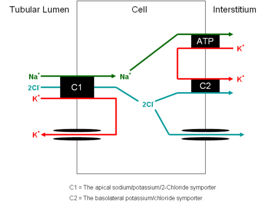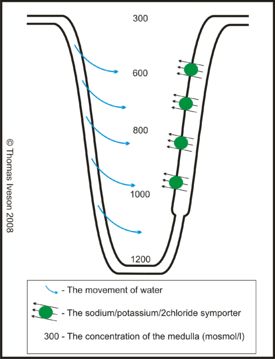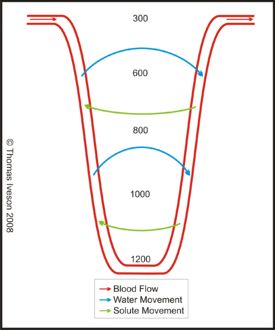Reabsorption and Secretion Along the Loop of Henle - Anatomy & Physiology
Function
- The aims of the loop of henle is to reduce the volume of water and solutes within the urine but without changing the concentration. In doing this it creates a hypertonic medulla
- It does this by using a countercurrent multiplier
- This is maintained by the vasa recta
- This hypertonic medulla not only helps reabsorb water from the loop of henle but also aids the reabsorption of water from the collecting ducts as well as they pass through the medulla en-route to the renal pelvis
Three Parts
Thin descending limb
- Freely permeable to water
- Therefore passive transfer of water occurs
- Relatively impermeable to salt
- No active transport
- Simple squamous epithelium
Thin ascending limb
- No active transport of salt
- Highly permeable to Sodium and chloride ions which cross the membrane via diffusion and enter the tubule
- Permeability to water very low
- Simple squamous epithelium
Thick ascending limb
- Active transport of Na+, K+ and Cl- in a 1:1:2 ratio
- Using a co-transporter
- Impermeable to water
- Simple Cuboidal epithelium
Transport
- Transport of sodium, potassium and chloride from the tubule to the interstitium in the thick ascending limb is done using a Sodium/Potassium/2-Chloride co-transporter.
- 20% of the filtered sodium is reabsorbed thanks to the countercurrent multiplier from the thick ascending limb.
- Potassium leaks back into the tubule through special channels
- As with the Proximal Tubule:
- Na+ / K+ ATPases in the basolateral membrane move potassium into epithelial cells from the intercellular spaces in order to remove sodium
- Potassium is then cleared from the cells using a co-transporter with chlorine
- Cations (e.g. sodium, potassium, calcium and magnesium) can passively move paracellulary into the vasa recta
Urea Recirculation
The urea from the collecting duct enters the medullary interstial fluid and diffuses into the loop of henle. As it passes back up the ascending limb of the loop of henle and reabsorption of other ions occurs the urea becomes even more concentrated. This recirculation can occur several times and steadily increases urea concentration in the medullary tissue until equilibrium is reached. If water conservation is important this equilibrium is not reached until the urine is more concentrated and urea makes up 40% of the interstial osmolarity. The overall aim of this recirculation is to excrete a high concentration of urea in very little water.
Countercurrent System
As the thin descending limb makes its way into the medulla the surrounding tissue becomes ever increasingly hypertonic and therefore the osmotic gradient increases the deeper the limb goes. As the limb is permeable to water it leaves the tubule via osmosis. The tube then bends back on itself and heads back up the cortex. The thin ascending limb is entered. Here salt enters the tubule passively due to the hypertonicity of the medulla creating a gradient. This results in a very high salt concentration at the bottom of the loop. The fluid moves on and enters the thick ascending limb. This has salt transporters and so salt is pumped into the medulla via active transport causing more water to leave the thin descending limb. The vasa recta has a similar countercurrent uptake system and only removes what is absorbed maintaining the medulla in a hypertonic state.
This is a challenging concept which is hard to explain. It is explained below in a different way:
- "Descending limb is permeable to water but not solutes"
- "The thick ascending loop is not permeable to water but solutes are pumped out"
- "Therefore, osmolarity of peritubular space is elevated, which draws water out of the descending limb"
- "Therefore, solute concentration of the fluid in the ascending limb is higher... causing more pumping"
- "Therefore, osmolarity of peritubular space is elevated, which draws more water out of descending limb"
Courtesy of Dr Ali Mobasheri (University of Nottingham School of Veterinary Medicine and Science)
Due to the transport of sodium and chloride from the thick ascending limb, the concentration of the urine as it passes up this limb decreases back down to around the level it was when it entered the loop. However the volume is greatly reduced. The collecting duct is where most concentration happens however it is only possible thanks to the incredibly high concentrations of NaCl at the bottom of the loop. This returning of the concentration back to the same level as when it entered the loop is important for retaining salt and also allows the concentration to be finely controlled by the collecting ducts without the loss of salt.
When there is excess water in the body, the excess fluid passes through the loop of henle because the fluid entering the loop is less concentrated already. The solutes only have so much osmotic potential and therefore are unable to draw the excess water from the lumen. This contributes to allowing the kidneys to produce dilute urine.
Vasa Recta Physiology
Water, salts and urea can pass freely across the capillary walls of the vasa recta and therefore as the vessels reach deeper into the medulla where the interstitum surrounding them becomes more hypertonic, the blood inside them in turn becomes more hypertonic. As the blood ascends back out of the medulla, the osmolarity reduces until it is only slightly higher than when it entered. The conclusion drawn from this is that the solutes which are reabsorbed from the fluid mainly remain in the surrounding tissue and maintain the concentration gradient. If the system was not arranged in loops then this would not be possible. Although the blood leaving the medulla is always slighty more concentrated than when it entered upon reaching the cortex, if the urine being produced is very concentrated, it actually becomes hypo osmolar as more water than salt is being reabsorbed in the distal tubules which reside in there. Overall the osmolarity of the blood decreases when concentrated urine is being produced and increased when dilute urine is being produced.
The anatomy of the vasa recta can be found here
Revision
Use the flash card revision resource for this section to test yourself.
Error in widget FBRecommend: unable to write file /var/www/wikivet.net/extensions/Widgets/compiled_templates/wrt6627be08828f76_59376565 Error in widget google+: unable to write file /var/www/wikivet.net/extensions/Widgets/compiled_templates/wrt6627be08859fe2_31237313 Error in widget TwitterTweet: unable to write file /var/www/wikivet.net/extensions/Widgets/compiled_templates/wrt6627be08886e05_16837566
|
| WikiVet® Introduction - Help WikiVet - Report a Problem |


